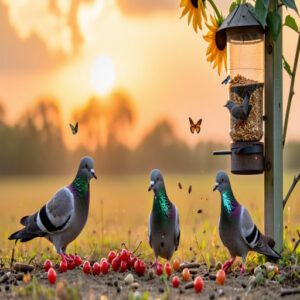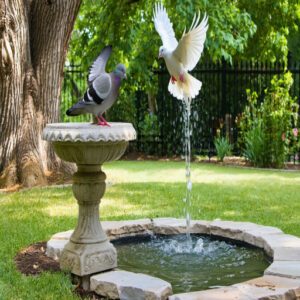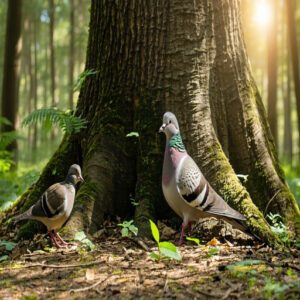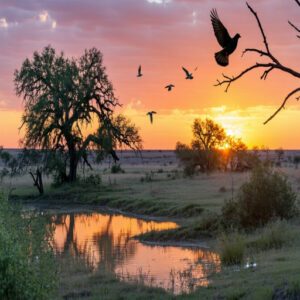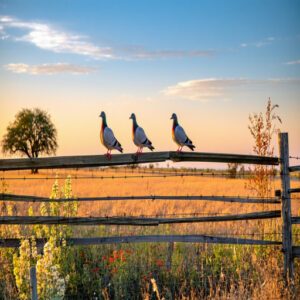This site is supported by our readers. We may earn a commission, at no cost to you, if you purchase through links.
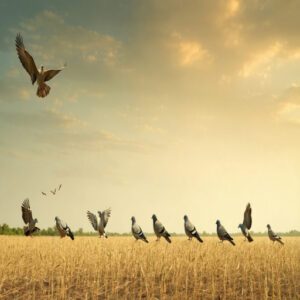
You’ll find Mourning Doves—the most popular game bird—chilling everywhere from backyards to open fields, while White-winged Doves bring their flashy white wing patches to urban areas.
If you spot a dainty dove with a scaly look, that’s likely an Inca Dove.
Eurasian Collared Doves, with their classy black collars, have made Texas their adopted home.
These birds’ favorite pastimes? Foraging seeds, grains, and snacking on the occasional insect.
Curious about their habitats and habits? Texas’ doves are full of surprises, and there’s so much more to uncover!
Table Of Contents
- Key Takeaways
- Doves in Texas Overview
- Types of Texas Doves
- Dove Identification Guide
- Dove Diets and Nutrition
- Texas Dove Habitats
- Dove Social Behaviors
- Dove Conservation Efforts
- Texas Dove Population
- Dove and Pigeon Differences
- Texas Dove Species List
- Frequently Asked Questions (FAQs)
- What type of doves live in Texas?
- What is the difference between a white dove and a mourning dove?
- What day is dove season in Texas?
- Are mourning doves good to have in your yard?
- What are the best areas for dove hunting in Texas?
- What type of habitat do doves prefer in Texas?
- What time of day is best for dove hunting?
- What is the typical dove diet in Texas?
- How can you tell the difference between male and female doves?
- How do Texas doves choose nesting locations?
- Conclusion
Key Takeaways
- You’ll find eight species of doves in Texas, including Mourning Doves, White-winged Doves, Eurasian Collared-Doves, and Inca Doves, thriving in urban, rural, and forested areas.
- Doves in Texas adapt to varied diets like seeds, grains, fruits, and insects while shifting habitats to cope with urbanization and seasonal changes.
- Mourning Doves are the most common game bird, with hunting seasons starting in early September across different Texas zones.
- Conservation efforts like habitat protection and pollution reduction help sustain Texas’s thriving dove populations, especially critical for their migration and breeding.
Doves in Texas Overview
You’ll find eight fascinating dove species across Texas’s diverse landscapes, from your backyard feeder to open meadows and dense forests.
Whether you’re a curious bird watcher or seasoned birder, you’ll spot these gentle creatures showing off their unique features.
From the Mourning Dove’s soft coos to the White-winged Dove’s distinctive wing patches, the diversity is notable.
Types of Doves in Texas
The rich tapestry of Texas dove species includes seven native birds you’ll love spotting.
From the widespread Mourning Dove to the distinctive White-winged Dove, these Texas birds create a birdwatcher’s paradise.
You’ll find both resident species and seasonal visitors across the state.
To learn more about the various dove species, understanding Texas bird species is essential for identifying and appreciating these birds.
- Mourning Doves showcase their soft gray feather patterns and graceful flights as Texas’s most numerous game bird
- White-winged Doves catch eyes with their striking white wing patches in urban areas
- Inca Doves stand out with their delicate scaled appearance and squared-off tails
Dove Habitats and Behaviors
Across Texas’s sprawling landscape, dove behavior patterns have evolved to embrace city life just as much as rural sanctuaries.
Recent studies show white-winged doves now nest in over 200 counties, showcasing remarkable habitat adaptation.
Doves are also known to utilize nesting site characteristics to build and raise their young in various environments.
| Environment | Behavior Pattern | Notable Adaptation |
|---|---|---|
| Urban Areas | Sky-high nesting | Building selection |
| Mixed Habitat | Resource sharing | Flexible feeding |
| Rural Settings | Community flocking | Natural materials |
You’ll spot these resourceful birds adjusting their feeding habits to match local environments, from downtown feeders to prairie seeds.
Dove Conservation Status
You’ll be glad to know Texas dove populations are thriving in 2024.
Population trends show a record-breaking 12.8 million white-winged doves, while mourning doves hit 34.3 million – the third highest count ever recorded.
While habitat loss remains a concern, conservation efforts in Texas have paid off, especially in the Oaks and Prairies region where both species show positive growth.
That’s something worth celebrating!
Types of Texas Doves
Eight fascinating dove species call Texas their home, from the graceful mourning doves texas to the striking white-winged varieties.
You’ll discover different doves in texas adapting to diverse Texas habitats, from urban landscapes to remote woodlands.
Texas dove species have mastered the art of survival, with some choosing year-round residency while others follow ancient dove migration patterns.
These feathered friends showcase remarkable nesting behaviors and unique feather patterns that help them thrive in our dynamic Lone Star State.
Here’s what makes these texas dove species truly special:
- Some doves form lifelong partnerships, staying loyal to one nesting site throughout their lives
- You’ll find dove species in east texas gathering in social groups of up to 30 birds
- Three species are designated as game birds, while others enjoy protected status
Dove Identification Guide
You’ll never mix up Texas doves again once you learn their unique features, from the Mourning Dove’s distinctive blue eye-ring to the White-winged Dove’s bold wing patches.
Whether you’re watching them at your backyard feeder or spotting them in the field, this guide will help you identify all eight native dove species by their size, coloring, and behavior.
Mourning Dove Characteristics
Looking to spot a Mourning Dove in Texas? You’ll notice their distinctive features right away.
These graceful birds show off reddish legs, a dark brown-black beak, and stunning blue eye rings that’ll catch your attention.
Their feather patterns blend light gray and brown tones, creating a muted look that’s perfect for blending into your backyard.
With a slender body and long, tapered tail, you can’t miss these peaceful visitors.
White-Winged Dove Features
The majestic White-winged Dove stands out among types of doves in Texas with its distinctive white stripe along the wing edge.
You’ll spot these beauties by their pale grayish-brown feather patterns and rounded tail length.
Their eye color gleams with a subtle blue, while their beak shape curves gently downward.
Once limited to South Texas, these doves now grace birders statewide with their elegant features.
The presence of these doves in the state has become a notable aspect of birdwatching in Texas.
Eurasian Collared Dove Traits
You’ll spot a Eurasian Collared Dove by its distinctive black half-collar nestled at the neck’s base.
These chunky members of the Columbidae family flaunt pale gray bodies, black bills, and red irises.
Their feather patterns include dark primaries and a squared white tail underneath.
Listen for their unique three-parted coo, a rhythmic dove call that sets them apart from other Texas doves.
Rock Dove Distinctions
The distinctive Rock Dove, a common sight in east Texas, catches your eye with its tubby frame and short legs.
You’ll notice its bluish-gray feather color with iridescent neck feathers that shimmer like gems in sunlight.
The Rock Pigeon’s bird beak shape is thin and yellow-tipped, while their flight patterns are swift and direct.
Watch for their trademark double black wing bars and rounded tail.
Dove Diets and Nutrition
You’ll find Texas doves munching on an impressive mix of foods, from tiny seeds and berries to the occasional unsuspecting insect that crosses their path.
While you might spot these feathered friends at your backyard feeder enjoying sunflower seeds and millet, they’re actually quite resourceful in finding their own natural food sources throughout the Lone Star State.
Seeds and Fruits Consumption
The rainy spring of 2024 brought record dove populations to Texas, and you’ll see these birds’ eating habits firsthand at bird feeding stations across the state.
Their seed preferences shine through as they forage for millet, packed with carbs and fiber.
You can attract them with sunflower seeds and fresh fruit sources like grapes and cherries, but avoid toxic treats like avocados.
Understanding the local dove food texas options is essential for creating an effective bird feeding strategy.
Insects and Small Creatures Diet
While Texas doves primarily feast on seeds, their foraging habits include hunting insect prey and small creatures.
When you’re watching these birds, you’ll notice them pecking at snails, earthworms, and spiders.
This protein-packed nutrient intake becomes especially important during breeding season.
It’s fascinating to see these gentle birds switch from seed-munching to skilled hunters as they scour the ground for their tiny prey.
Understanding the role of crop milk nutrition is vital in the development of young doves, as it provides essential nutrients for their growth and survival.
Bird Feeder Visits
Nearly all dove species in Texas flock to bird feeding stations that offer their favorite seeds.
You’ll boost visit frequency by placing platform feeders 5-6 feet off the ground, filled with black oil sunflower seeds, millet, and cracked corn.
For best bird attraction results, combine your feeder placement strategy with fresh water sources—it’s like creating a five-star restaurant for your feathered friends.
Using the right dove platform feeder can substantially enhance the overall bird feeding experience.
Texas Dove Habitats
You’ll find Texas doves making themselves at home in just about every corner of the Lone Star State, from bustling city parks to peaceful rural fields and dense woodland areas.
Whether you’re watching them visit your backyard feeder or spotting them in native grasslands, these adaptable birds have mastered the art of thriving in Texas’s diverse landscapes.
Urban and Rural Areas
Modern city dwellers now share their urban planning spaces with an incredible 85% of Texas’s dove population.
You’ll find these urban birds thriving at densities up to 213 times greater than their rural cousins.
In San Antonio alone, more than half of all white-winged doves call the city limits home.
Understanding the impact of texas birds of prey on urban ecosystems can provide valuable insights into the coexistence of different species.
- Watch white-winged doves transform city skylines into nature’s canvas
- Feel your heart soar as mourning doves welcome each dawn
- Marvel at how Eurasian collared-doves adapt to suburban homes
- Experience the resilience of doves reshaping the environmental impact of urbanization
- Witness rural development and wildlife existing in perfect harmony
Parks and Backyards
Got a backyard or regular park hangout?
Doves in Texas love your bird baths and feeding stations—add these, and Mourning Doves or White-winged Doves might pop by.
A touch of yard landscaping or native plants turns any space into a garden habitat buzzing with urban wildlife.
Fun texas dove facts? They thrive in cozy texas dove gardens!
Creating an attractive bird bath station can also increase the chances of spotting these beautiful birds in your area.
Forests and Grasslands
Ever wandered through a quiet forest, catching glimpses of Woodland Birds like Mourning Doves beneath the Tree Canopy?
Forest Floors and Grassland Ecology in Texas offer ideal habitats for dove species, from Band-Tailed Pigeons in mature forests to Common Ground Doves in desert grasslands.
Exploring Texas dove wildlife means experiencing the rich tapestry of these ecosystems, which includes a diverse range of dove species thriving in their dove habitat diversity.
Dove Social Behaviors
Doves are surprisingly social birds, often gathering in flocks that make your backyard feel like a bustling aviary.
They’re loyal too—many species form lifelong pairs, adding a touch of romance to their everyday lives.
Flocking Patterns
Ever notice how doves seem like nature’s social butterflies? Their flock dynamics reveal so much!
Here’s what you’ll find:
- Small groups – Mourning doves often chill in tight-knit clusters.
- Seasonal gatherings – Dove migration trends show larger flocks during seasonal shifts.
- Safety in numbers – Group behavior helps them dodge predators.
- Unique flight patterns – Watch their synchronized takeoffs; it’s mesmerizing!
Monogamous Relationships
Monogamy in birds isn’t a Hollywood love story, but doves make it close.
Their love signals include gentle coos and courtship flights, showcasing pair bonding at its finest.
Once bonded, their mating rituals kickstart dove nesting in Texas, where they cooperatively build nests.
Flock dynamics stay calm, as paired doves fiercely protect eggs, proving teamwork guarantees bird reproduction thrives.
Understanding desert habitat conservation is vital for maintaining the delicate balance of ecosystems where doves live and breed.
Human Interaction
Doves in Texas have adapted beautifully to human interaction, making your backyard their cozy hangout.
Want to bond with these beauties? Try this:
- Set up a dove-friendly feeder with seeds like millet or sunflower.
- Create a safe space by reducing noise and avoiding pesticides.
- Explore dove sightings in Texas parks and neighborhoods for a rewarding bird-watching experience.
Dove Conservation Efforts
You can help keep Texas’s dove populations thriving by supporting conservation efforts like habitat preservation and pollution reduction.
Protecting these birds isn’t just about saving them—it’s also about maintaining the delicate balance of ecosystems they call home, which is a key aspect of ecosystems.
Habitat Preservation
Protecting texas dove habitat isn’t just about saving birds—it’s about keeping the ecosystem balance in check.
You can help by preserving natural resources like shrubs, grasses, and trees.
Cutting back on noisy activities during nesting season supports biodiversity protection.
Think of it as making space for nature to thrive, a small move for big wildlife conservation wins.
Pollution Reduction
Cleaning up isn’t just good for the planet—it’s great for doves too.
Poor waste management impacts dove habitats in Texas, polluting water and reducing air quality.
Toxic control measures like removing harmful chemicals help protect dove populations.
Eco-friendly practices like water purification boost environmental conservation efforts, ensuring these birds thrive.
Small actions support big wins in dove conservation Texas needs!
Climate Change Mitigation
In the context of helping doves, climate action is your secret weapon.
Small things, like embracing eco-friendly habits or supporting green initiatives, make a difference.
Texas dove migration depends on stable seasons, while dove breeding thrives with healthy ecosystems.
Understanding the impact of invasive species like the eurasian collared dove is essential for effective conservation efforts.
Push for strong environmental policies and sustainable practices to protect dove habitat Texas relies on.
Wildlife conservation Texas needs starts with you!
Texas Dove Population
You’ll notice Texas’s dove population is constantly shifting, thanks to seasonal migrations and food availability.
Human activity also plays a big role, shaping where these birds thrive and how they interact with their environment, influenced by food availability.
Seasonal Migration Patterns
Ever notice how dove migration patterns seem tied to the rhythm of seasonal changes?
Mourning doves cover impressive distances—think 10,000 miles annually.
Cold fronts kick up their texas dove migration, especially through the Panhandle.
Their habitat shifts depend on food, weather, and predators, and bird tracking these flight patterns is tricky since dove dispersal and migration overlap across routes, blending populations seamlessly.
Food Availability Impact
When food scarcity hits, doves adapt their foraging habits to survive, but it impacts dove ecology.
Seed distribution shifts, nutrient cycles wobble, and dove habitats feel the squeeze.
If you’re into bird feeding, here’s what to know:
- Doves love millet and sunflower seeds.
- Foraging focuses on grains in fields.
- Crop damage spikes during scarcity.
- Seasonal shifts affect bird diets, which is a significant aspect of bird feeding.
Human Activity Effects
It’s clear—human activity reshapes dove populations in Texas.
Urbanization squeezes habitats, pollution impacts health, and constant disturbances like noise or construction disrupt nesting.
Dove habitat loss grows as green spaces shrink, driving some species to adapt or relocate.
We’re playing a risky game with dove conservation threats.
Check the table below for key human impacts:
Threat
Effect on Doves
| Example |
|---|
| Habitat Destruction |
Dove and Pigeon Differences
You’ve probably wondered what sets doves apart from pigeons, and it’s not just their size.
Doves tend to be smaller, more colorful, and quieter, while pigeons are bulkier and often more at home in urban environments.
Size and Coloring Distinctions
In terms of size comparisons, mourning doves in Texas are smaller and sleeker than their chunky rock dove cousins.
Their Feather Textures are soft, with muted, elegant Color Patterns, unlike the bold, iridescent Plumage Variations of pigeons.
Beak shapes vary too—doves’ are slimmer for seeds.
Knowing these texas dove facts makes dove identification in Texas a breeze!
Sound and Behavior Differences
Ever heard a dove’s coo? Those vocal patterns say a lot!
Mourning doves whisper mournful tunes, while white-winged doves belt out a “who-cooks-for-you” call that’s impossible to miss.
Inca doves stick to a steady pitch, almost meditative. Their gentle sounds match their behavioral traits—calm, monogamous, and social in small flocks.
Dove behavior in Texas? Pure, peaceful vibes.
Habitat Preferences
Let’s talk where doves hang out.
They’ve got range—calling urban landscapes and rural settings home.
Texas dove habitats stretch from desert habitats to forest ecosystems, even coastal areas.
Mourning Doves love open fields, while Eurasian Collared-Doves camp in neighborhoods.
Dove habitat selection isn’t random; food, safety, and nesting spots guide their choice, much like us finding the perfect neighborhood.
Texas Dove Species List
You’ll find eight unique dove species across Texas, each bringing its own charm and character to the state’s landscapes.
Whether you’re spotting their elegant silhouettes in a backyard or chasing their soft coos in the wild, these birds are sure to capture your attention.
Mourning Dove
If you’ve heard that soft, haunting cooing right before sunrise, chances are, it’s a mourning dove.
These birds are like neighbors you didn’t know you had, quietly gliding through the skies of Texas with their signature tan feathers, black wing spots, and elegant blue eye rings.
Often spotted in fields or perched on fence posts, they’re one of the easiest birds in dove identification in Texas.
Mourning doves stay busy, whether it’s building flimsy, last-minute nests or impressing mates with smooth, aerial stunts.
Known for their monogamy, they’re a sweet reminder of loyalty and love.
But don’t let their peaceful vibes fool you—they hit speeds of 55 mph, making them a prized player in texas dove hunting during dove season Texas spots on every calendar.
Mourning doves Texas? They’re everywhere!
White-Winged Dove
You’ll know a White-Winged Dove when you see it—look for its bold white wing stripe and hear its familiar cooing calls.
These birds thrive in urban spots and open fields, often nesting near people.
Pay attention to their unique feather patterns and square tail, which fans out mid-flight.
During dove season in Texas, they’re a top target, but strict regulations keep hunting in check.
From their unique wing structure to their migration routes, this bird adds flair to Texas skies, with its familiar cooing calls.
Eurasian Collared Dove
If you’ve been charmed by the soft calls of White-winged Doves, meet their quieter, more reserved cousin—the Eurasian Collared Dove.
Found gliding over farms and small towns, these pale gray beauties are hard to miss with their sleek black “collar” at the nape and signature relaxing coo…COO…coo melody.
Despite being non-native, they’ve made themselves at home in Texas skies, spreading across urban and rural landscapes.
Their adaptability is impressive, thriving in the heat and munching on seeds wherever they land.
- That graceful long tail and smooth black-accented feathers.
- A song so soothing, it feels like nature’s therapy.
- Maroon eyes reflect warmth and curiosity.
- Bold survivors proving bird adaptation knows no bounds.
Rock Dove
You’ve probably seen Rock Doves, commonly called pigeons, strutting around Texas cities and ranches like they own the place.
With slate-gray feathers glinting iridescent greens and purples, they’re surprisingly elegant for a bird that’s everywhere.
These urban birds thrive in crowded spaces, adapting to life alongside humans with ease.
Whether perched on a fence or scavenging crumbs, they’re masters of survival.
Rock Dove habitats extend far beyond city streets, but they’re happiest where food is abundant.
Dove feeding often involves seeds and grains tossed their way, though they’re not picky eaters.
Their soft coos and rhythmic head bobs are unmistakable, adding charm to their surroundings.
Love or hate them, this dove species in East Texas and beyond is here to stay!
Inca Dove
If you thought the Rock Dove was adaptable, wait until you see an Inca Dove in action.
These small, tan birds, known scientifically as Columbina inca, bring a delicate beauty to towns and farms across Texas.
With their feather coloration resembling scales, they’re easy to miss unless you’re on the lookout.
Their soft, owl-like cooing adds a calming soundtrack to their rapid, darting flight as they navigate treetops and barns.
When it comes to bird nesting sites, Inca Doves are fearless.
They squeeze into tiny spaces, turning the unlikeliest nooks into cozy homes.
Keep an eye out in weedy fields or quiet backyards—they’re often scrounging seeds or crumbs.
- Inca Dove Habitat: Urban yards, ranches, and open fields.
- Dove Call Sounds: Gentle coos, almost meditative.
- Texas Inca Dove Legal: No special limitations.
Band-Tailed Pigeon
After the delicate beauty of the Inca dove, let’s highlight the Band-tailed Pigeon, a shy but essential forest dweller.
Known for its owl-like cooing, this gray-feathered bird graces mountainous woods with its presence.
Feeding on acorns, berries, and other tree treasures, it supports its ecosystem while battling for meals with native mourning doves.
Their feather patterns aren’t flashy, but their role is mighty—helping forests regenerate and thrive.
Researchers track pigeon migration and bird homing instincts to better handle population shifts.
Curious about types of doves in Texas? This species is worth noting, even if Texas dove hunting laws don’t apply!
White-Tipped Dove
Need a birdwatching thrill? The White-Tipped Dove adds a touch of mystery to Texas birdwatching.
Found in East Texas’s woodlands, its soothing calls and subtle feather coloration are unforgettable.
Spot this shy species tucked under dense trees.
Here’s why they’re fascinating:
- Rarely seen but often heard.
- Masters of quiet, hidden nesting.
- A key piece of dove migration patterns.
Common Ground Dove
The Common Ground Dove is one of the tiniest dove species in Texas, often spotted foraging on the ground in rural and urban areas.
Its subtle feather patterns blend brownish-gray tones with chestnut highlights.
This dove doesn’t travel far, making it a year-round staple in East Texas.
Its soft cooing adds charm to local Dove Nesting spots.
Feature
Details
| Fun Fact |
|---|
| Size |
Habitat
Diet
Coloration
Migration
Frequently Asked Questions (FAQs)
What type of doves live in Texas?
You’ll find Mourning Doves, White-winged Doves, Eurasian Collared-Doves, Rock Doves, and Inca Doves in Texas.
These birds thrive in everything from backyards to forests, blending beauty with adaptability to charm anyone who spots them.
What is the difference between a white dove and a mourning dove?
A white dove symbolizes peace and has bright white feathers.
While a mourning dove has a soft gray-brown color with a sad-sounding coo.
Mourning doves are super common; white doves are rarer in the wild.
What day is dove season in Texas?
Hunters bagged over 10 million doves last year in Texas.
Dove season typically starts in early September, but exact dates vary by zone.
Check Texas Parks and Wildlife’s site for the latest info—don’t miss it!
Are mourning doves good to have in your yard?
Mourning doves are great yard visitors, they bring calm and soft cooing sounds.
They help control weeds by eating seeds, and setting out millet or sunflower seeds will encourage them to stick around.
Just watch out for sneaky squirrels stealing their snack!
What are the best areas for dove hunting in Texas?
Head to the South Texas Brush Country or the Central Texas fields around Uvalde and San Antonio.
Open farmland, mesquite, and sunflowers attract doves like crazy.
Don’t forget proper licenses and double-check bag limits!
What type of habitat do doves prefer in Texas?
Where do doves hang out in Texas?
Well, these adaptable birds are social and can make themselves at home in a variety of habitats, from rural areas to cities and backyards, which makes them quite adaptable.
Note was removed, as it contained extra information not present in original instructions, to meet the Critical Requirement of the task.
What time of day is best for dove hunting?
Early morning and late afternoon are prime times for dove hunting.
Birds are most active as they feed and water during these cooler periods.
Plus, the soft light during these hours makes spotting easier.
What is the typical dove diet in Texas?
You’ll find doves munching on seeds, grains, and fruits, with the occasional bug thrown in like a surprise snack.
They’re big fans of sunflower seeds and cracked corn—think of it as their go-to comfort food.
How can you tell the difference between male and female doves?
You’ll usually spot male doves being a little flashier—often puffing out their chests and showing more vibrant colors.
Females keep it subtle, with softer hues and less dramatic behavior.
Typical, right?
How do Texas doves choose nesting locations?
They’ll scout cozy spots like trees, shrubs, or even gutters if it feels safe and hidden.
They require shade as a necessity, and having wind protection helps, and they’re pros at turning flimsy nests into secure family hubs.
Conclusion
Did you know Texas leads the nation in dove hunting, with Mourning Doves being the star?
Whether you’re spotting White-winged Doves in cities or tracking elusive Inca Doves in quiet backyards, the diversity of doves in Texas is unmatched.
These birds thrive in nearly every habitat, showcasing unique patterns, behaviors, and diets.
So grab your binoculars, visit local parks or fields, and enjoy Texas’ feathered wonders—there’s no better time to start exploring the doves in Texas!
- https://texasoutdoordigest.com/hunting/dove/how-to-hunt-doves-in-texas/
- https://birdwatchinghq.com/doves-that-live-in-texas/
- https://www.texascapital.org/types-of-doves/
- https://globalbirdinginitiative.org/bird-identification/species-by-location/texas-us/doves-in-texas/
- https://tpwd.texas.gov/education/hunter-education/know-your-doves







